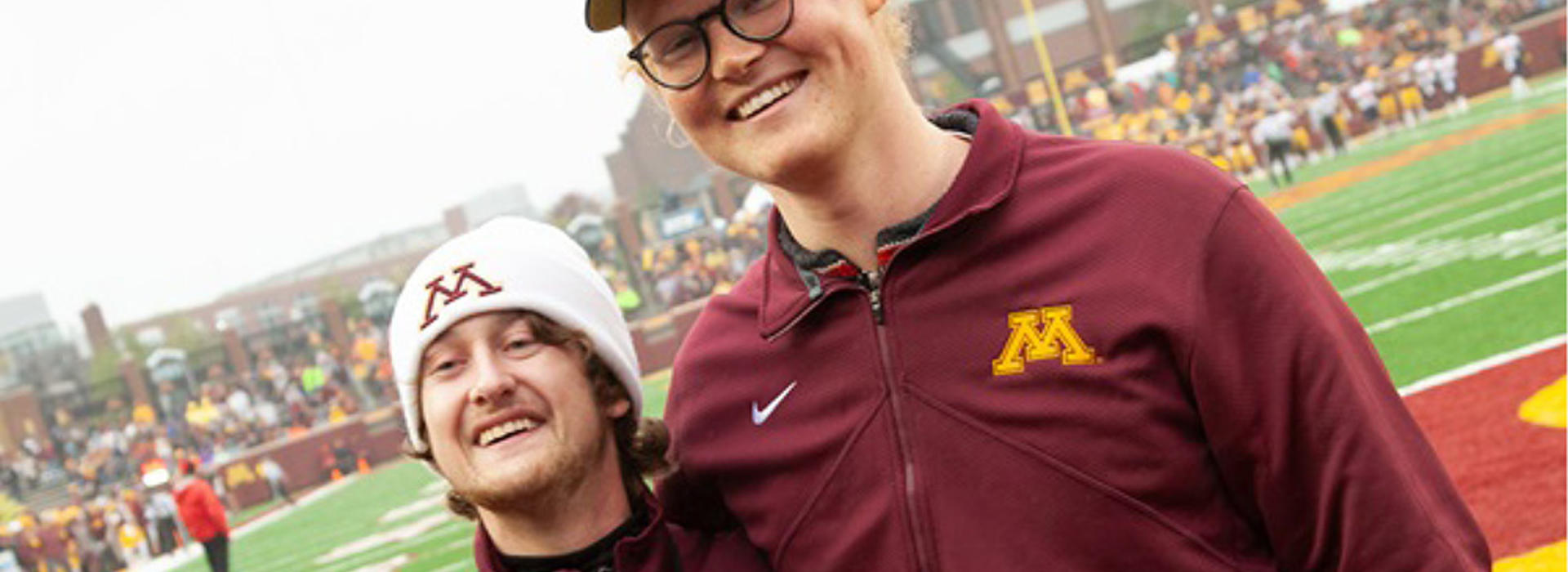
U of M Medical School Research on Blood and Marrow Transplantation (BMT) Revolutionizes Transplant Survival Rates
It was an emotional day as Kyle Tanner and Manuel Suilmann met for the first time at the Gopher Football Homecoming game in early October. Tanner, who was diagnosed with Fanconi anemia, required a bone marrow transplant as his own bone marrow was rapidly failing with early signs of leukemia. An international search for a perfectly matched donor was undertaken and a match was found–in Germany–where Suilmann, a 20-year-old, decided to help. That was two and a half years ago.
“I wouldn’t be here today without my donor,” Tanner said.
One month ago, Suilmann was contacted by “Be the Match” which found the donor for Tanner. The University of Minnesota has pioneered bone marrow transplants for more than 50 years, performing the world’s first successful bone marrow transplant in 1968 under the direction of Dr. Robert Good, a renowned immunologist. John Wagner, MD, professor in the Department of Pediatrics at the U of M Medical School continued that legacy of firsts, helping revolutionize the field since the late 1980s. From 2005 to 2019, he was the director of the pediatric blood and marrow transplantation team at M Health Fairview University of Minnesota Masonic Children’s Hospital, stepping down recently to serve as the inaugural director of the Institute for Cell, Gene, and Immunotherapy.
During the 1990s, Dr. Wagner began to focus his research on Fanconi anemia, a particularly challenging group of patients because the disease results from an underlying defect in DNA repair. As a result of this defect, the median survival was 17 years with most dying of bone marrow failure or leukemia. When treated by bone marrow transplant, they frequently experienced catastrophic complications because they could not tolerate traditional doses of chemotherapy and radiation.
“In the 1990s, only 16% survived the transplant procedure; understandably, parents avoided such treatment until there was no other option. Their bodies just could not tolerate it,” Dr. Wagner explained.
He and his team discovered a type of therapy they could use to treat patients - one that their bodies could tolerate. The revolutionary step that changed everything was when Dr. Wagner realized that these children with Fanconi anemia could tolerate one type of chemotherapy drug and together with a low dose of radiation. Still, it took another decade to achieve the results observed today.
“I started testing different combinations of chemotherapy and radiation in 1996, and the first big breakthrough came in 1999. All of a sudden, the patients were getting through the transplant in a way that had never been seen before. Between 2000 and 2015, we saw a whole transformation moving survival rates from 16% to 90%,” he said.
In 1999, Margaret MacMillan, MD, completed a BMT fellowship at the U of M, and joined Dr. Wagner in research and patient trials. Now a professor of pediatrics in the Division of Blood and Marrow Transplantation at the Medical School and a pediatric hematologist and oncologist at Masonic Children’s, MacMillan and Wagner have been able to break through barriers over a series of clinical trials, building on a series of discoveries. This is one example of a list of important successes for the U of M BMT Program which has provided transplants to more than 8,000 people with life-threatening leukemia, lymphoma, aplastic anemia, sickle cell disease, various metabolic diseases and immune deficiency states. While not everyone is cured by transplant, success stories, like Tanner’s, are increasing.
“Dr. Wagner has always been there ever since I began seeing him. Not only is he a great medical professional, but he has also been a good friend,” Tanner said.
Learn more about how Tanner and Suilmann met, by reading the full story.